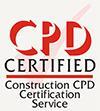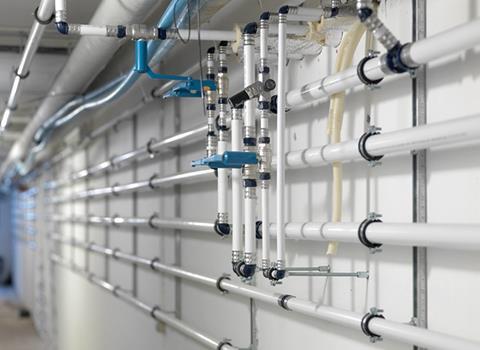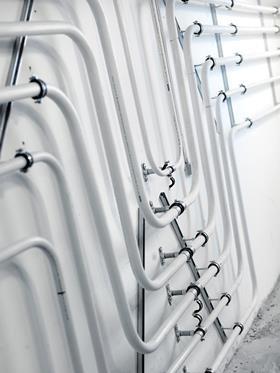This module sets out the advantages of a pumped, circulating drinking-water system in preventing the growth of Legionella bacteria. It is sponsored by Wavin

How to take this module
UBM’s CPD distance-learning programme is open to anyone seeking to develop their knowledge and skills. Each module also offers members of professional institutions an opportunity to earn between 30 and 90 minutes of credits towards their annual CPD requirement.
This article is accredited by the CPD Certification Service. To earn CPD credits, read the article and then click the link below to complete your details and answer the questions. You will receive your results instantly, and if all the questions are correctly answered, you will be able to download your CPD certificate straight away.
CPD CREDITS: 60 MINUTES
DEADLINE: 10 APRIL 2015
![]()
INTRODUCTION
A continuously operated recirculating system, sometimes referred to as a ring main, is a pumped, circulating drinking-water system. Water is maintained at a minimum temperature above 60oC (+/- 5°C), and is replenished with an incoming fresh supply to replace the drawn water. This means that hot water is always available at the tap.
Continuously operated recirculating systems are particularly popular in large sanitary environments such as healthcare facilities and residential care homes. As well as delivering clean hygienic water at the temperature required, such systems are attractive to these facilities because they discourage biofilm and legionella growth - the biggest concern regarding the hygienic quality of a water system.
This CPD will outline the causes of Legionnaire’s disease, and examine why a continuously operated recirculating system is a valuable tool for preventing the spread of Legionella bacteria. It will then demonstrate the lifetime performance of two common piping materials and how they react to different temperatures and methods of disinfection.

LEGIONNAIRE’S DISEASE
Legionnaires’ disease is a type of pneumonia, caused by a bacterium called legionella pneumophila. Humans catch Legionnaires’ disease by inhaling the bacteria contained in small droplets of water suspended in the air.
Certain conditions increase the risk of legionella growing and spreading. These include:
- A suitable temperature for growth, between 20-50°C. The optimum temperature for legionella bacteria is 35°C
- Lack of disinfectant in the water system
- The regular introduction of oxygen-carrying fresh water into the system to replace the drawn water
- Long-term stagnation of the water
- A favourable substrate or biofilm. A biofilm is formed where groups of microorganisms adhere to each other on the surface of a material, which can happen on any kind of surface. Even perfectly hygienic potable water contains bacteria and the nutrients that fuel their growth, and biofilms develop in all water-conveying systems, irrespective of the material used.
With this in mind, there are some general approaches that can be taken to avoid legionella growth. These include:
- Keeping cold water cold (below 20°C)
- Keeping hot water hot (above a minimum of 55°C), throughout the plumbing network during normal use
- Designing and installing the drinking water system in such a way that stagnation of the water under normal use is avoided
- Removing sediment, which can support the growth of Legionella, on a regular basis
- Minimising the formation of biofilm by ensuring cleanliness during installation and start-up, and reducing scaling and corrosion as much as possible. This can be achieved through the choice of appropriate system design, materials and maintenance regime.

ROLE OF CONTINUOUSLY OPERATED RECIRCULATING SYSTEMS
Continuously operated recirculating systems reduce the risk of Legionnaire’s disease because they provide fewer opportunities for bacteria to grow. By continuously pumping water through the pipework, they cut the risk of stagnation; the constant high temperature in the hot water system stops bacteria from breeding; and the faster distribution of hot water to the tap reduces the risk at danger areas such as outlets. This can also reduce water wastage and allow shorter output times.
A pump is used to continuously force heated water around the system, but the specific components will depend on the size and scale of the build and be determined by a range of factors, such as the number of outlets, inlet pressure, water quality, number of consumption units and height of the building.
Material selection is key when designing a continuously operated recirculating system. The chosen material needs to be resistant to the precautions and/or treatment applied to the system to ensure the water quality (ie, temperature and disinfectant).
These systems are also easier to disinfect than many other systems. There are two main approaches to disinfecting continuously operated recirculating systems:
Thermal disinfection The pipework of continuously operated recirculating systems should be designed to resist temperatures of 70°C for disinfection purposes. The water should be heated to 70°C and each tap or sampling point rinsed for a minimum of three minutes
Chemical disinfection Most large continuously operated recirculating systems are also treated in one of the following ways to manage water quality:
- A disinfectant such as chlorine is added to the water in small but continuous amounts - either to the public drinking water supply or by the operator of the facility itself
- A shock disinfection is carried out with a high amount of disinfectant for a short period of time - for example, in the case of a suspected infection.
Both methods of disinfection will affect the lifetime of a sanitary piping system. Material selection is key to this, as it needs to be resistant to the treatment applied, so that water quality is maintained. The next section will use a lifetime assessment tool, developed by supplier Wavin, to show the impact of the piping material on the durability of a continuously operated recirculating system subjected to regular disinfection.
LIFETIME CONSIDERATIONS
The lifetime of a piping system is influenced by many criteria. The most important are:
- Internal pressure
- Operating temperature
- Water quality
- Disinfectant additives (type and amount)
- Material used for system
Wavin has developed a lifetime assessment tool, a piece of software which can be used to determine the potential lifetime of a proposed water system, considering a range of criteria.
The examples below have used this tool to show the effect of different materials, operating temperature and chemical additives - all key factors in reducing legionella growth - on lifetime performance. Two materials will be considered: cross-linked polyethylene (PEXc) and polypropylene (PP-R). It is important to note that recirculating systems are excluded from the scope of BS 7291:2010, the British standard covering thermoplastics pipe and fitting systems for hot and cold water for domestic purposes and heating installations in buildings. This covers solid-wall PEX and polybutylene, neither of which should be used in continuously operated recirculating systems.
IMPACT OF TEMPERATURE, MATERIAL AND DISINFECTION ON PERFORMANCE
1: Impact of temperature on performance
The design criteria for this system include:
- No chlorine added to the public drinking water supply
- No chlorine added to the water system by the carrier of the installation
- 70°C backflow temperature
- System operating 100% of the time.
The life expectancy for this system, operating at 70°C, is 434 years using PEXc pipework and 117 years using PP-R.
Operating at 80°C, the life expectancy falls to 134 years for PEXc and 40 years for PP-R. Therefore, we can see that a 10°C increase in operating temperature results in a greater than 65% reduction in lifetime performance.
2: Impact of chlorine disinfection on performance
The design criteria for the system in this example include the following:
- Small amount of chlorine dioxide disinfectant added continuously to the water distribution (public and/or local)
- 60°C backflow temperature
- System operating 100% of the time.
The life expectancy for this system, using 0.5ppm of chlorine dioxide, is 66 years for the PEXc pipework, and 23 years for the PP-R.
At 2.5ppm of chlorine dioxide, the life expectancy falls to 40 years for PEXc and 12 years for PP-R. Therefore, we can see that a fivefold increase in chlorine dioxide results in a 40% reduction in lifetime performance.

How to take this module
UBM’s CPD distance-learning programme is open to anyone seeking to develop their knowledge and skills. Each module also offers members of professional institutions an opportunity to earn between 30 and 90 minutes of credits towards their annual CPD requirement.
This article is accredited by the CPD Certification Service. To earn CPD credits, read the article and then click the link below to complete your details and answer the questions. You will receive your results instantly, and if all the questions are correctly answered, you will be able to download your CPD certificate straight away.
CPD CREDITS: 60 MINUTES
DEADLINE: 10 APRIL 2015
Privacy policy
Information you supply to UBM Information Ltd may be used for publication and also to provide you with information about our products or services in the form of direct marketing by email, telephone, fax or post. Information may also be made available to third parties. UBM Information Ltd may send updates about Building CPD and other relevant UBM products and services. By providing your email address you consent to being contacted by email by UBM Information Ltd or other third parties. If at any time you no longer wish to receive anything from UBM Information Ltd or to have your data made available to third parties, contact the Data Protection Coordinator, UBM Information Ltd, FREEPOST LON 15637, Tonbridge, TN9 1BR, Freephone 0800 279 0357 or email ubmidpa@ubm.com. View our full privacy policy at www.building.co.uk/cpd





























2 Readers' comments